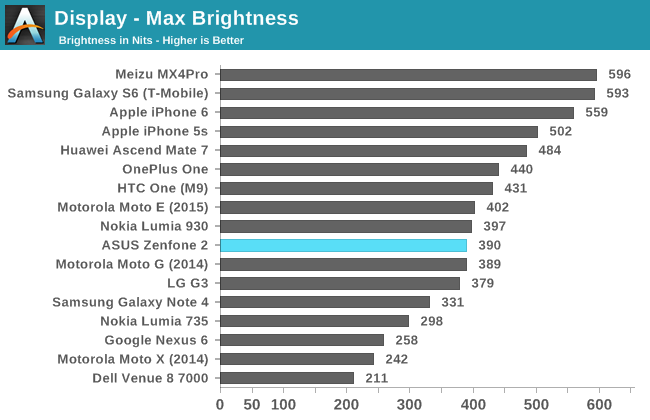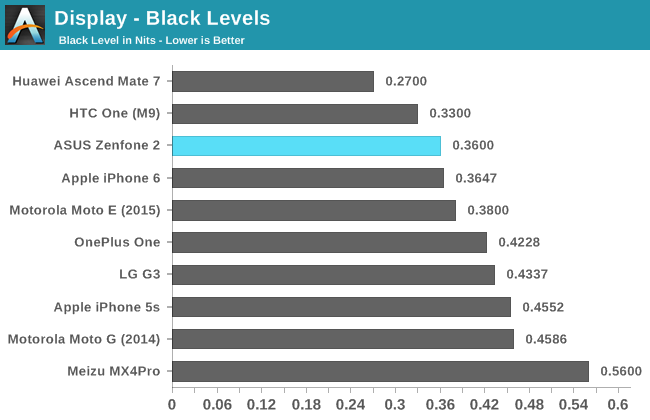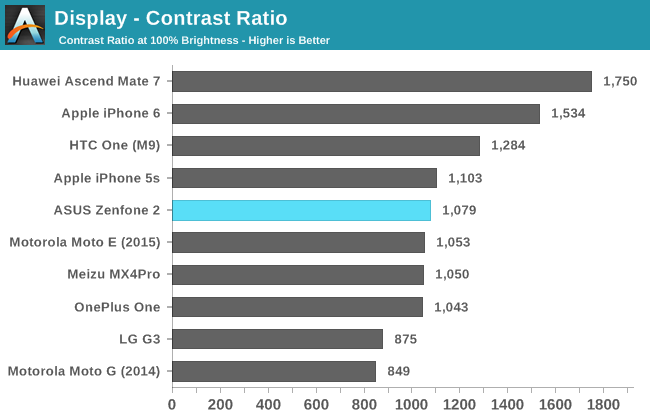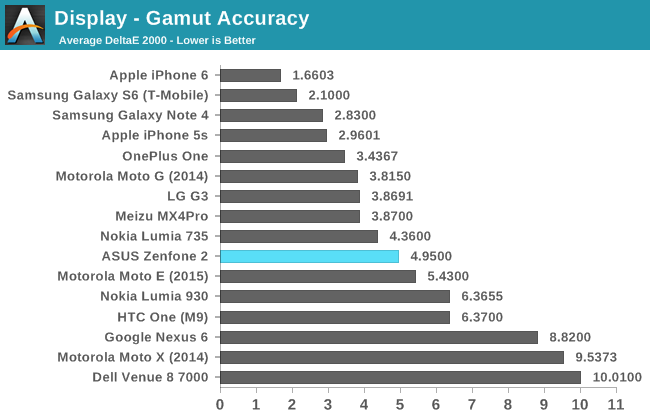The ASUS ZenFone 2 Preview
by Brandon Chester on May 18, 2015 2:00 PM ESTDisplay
I thought it would be important to give potential buyers some idea of how good the display is on the ZenFone 2. On paper it looks very good, as it's a 5.5" 1920x1080 IPS display. The pixel density isn't as high as the latest generation of 2560x1440 panels, but I find that with an RGB stripe panel the difference between 1920x1080 and 2560x1440 is minimal even at 5.5".


The ZenFone 2 appears to be off to a good start. Black levels are very low among our LCDs, and the max brightness is somewhat low but not terrible by any means. I never had any issues when using the ZenFone 2 outside, although it was definitely not as comfortable as the Galaxy S6.

The slightly low max brightness and above average black level results put the ZenFone 2 right in the middle of our LCD devices when it comes to contrast ratio.
Unfortunately, these numbers are somewhat misleading. This is because the ZenFone 2 makes extremely heavy use of dynamic contrast and contect adaptive backlighting. I have never used another device with such dramatic shifts in backlight power. The best example I've found is when switching from an all black to all white screen at max brightness. While this is obviously an extreme case, it illustrates the behavior that is occuring very well. At the moment you switch to white, the brightness of the display is around 170 nits. Over the next few seconds, that brightness rapidly increases to the 390 nits you see in the results above. This is an enormous jump in brightness, and it's very easy to see with your own eyes.
One last thing I'd like to note about the brightness is that the 100% setting on the built in brightness slider is not actually the max brightness that the display is capable of. The max you can achieve using the slider in the Settings app is 319 nits, which is around 82% of the 390 nit result you can get using applications like Brightness Adjuster from Google Play.

The gamut results are unfortunately not as good as what we've seen from the latest generation of smartphones. The DeltaE for red, blue, and magenta are all just over three, while the remaining three colors are around five. The high error in white also contributes to the higher than optimal overall error.
The complete review of the ZenFone 2 should be posted in the near future, and it will include the remainder of our display workflow. The heavy use of CABC and dynamic contrast has a large impact on the display's performance in some of our tests, and so I'll also be elaborating on where and why that occurs, and what it means for the user. For anyone who really wants to order the ZenFone 2 now, I'll conclude by saying that it's definitely not perfect, but it's still a good display. I think it's by far the nicest one you'll find on a phone that starts at $199 purely because of its resolution.











139 Comments
View All Comments
lilmoe - Monday, May 18, 2015 - link
I wish Intel would focus more on GPU in all of their lineup of silicon.MonkeyPaw - Monday, May 18, 2015 - link
That's what they did with CherryTrail. They shrunk the die, kept the CPU largely unchanged, and jumped to Gen 8 graphics with more EUs. Surface 3 has a newer GPU than Surface Pro 3!lilmoe - Tuesday, May 19, 2015 - link
Yea they did, but it's not enough though. It falls short of smartphone SoCs ATM.http://www.anandtech.com/show/9219/the-surface-3-r...
Alexvrb - Thursday, May 21, 2015 - link
It's a Windows x86 device... with a new GPU. A major driver update could turn things around, especially combined with DX12. They still need to pick up the pace though. Case in point:These Atom chips in question are powered by PowerVR graphics, not Intel. G6430 to be specific, so they should be reasonably quick. But Intel should be more aggressive in adopting the latest graphics cores from PowerVR - these should have been using GX6450, as seen in the iPhone 6. The G6430 was what Apple was using last gen.
akdj - Saturday, May 23, 2015 - link
Hi Alex. I agree with all you say, and wise to point out this isn't a graphic solution from Intel. That said, I'm not so sure about the second sentence. Driver updates certainly can help but as you say, it's last year's PVR silicon and there's a ceiling of headroom just as there is with the TDP of the CPU, the SoC's overall temp is governed by the GPU more often (as it's literally 'all display' ;)) than the CPU.However, seeing the advances Intel has managed on the desk and in the lap, I'm not betting against them, nor nVidia. While they 'missed the train' on its first stop, they've both got the resources to catch up. The knowledge, equipment and the know how to do so. Intel iGPUs over the life span of the core 'i' series since Core2Duo have gone from able to draw your desktop without mouse tracers to today's Iris Pro 6xxx series. While not 'monsters' in comparison to the discrete lineup of GPUs on the market ...today, they're certainly comparable to the discrete cards of yesterday. IE, I've got a 15" rMBP from 2012. It's a core i7/2.7GHz w/16GB of RAM, 786GB SSD and the Intel HD4000/nVidia 650m (kind of a 655/660 as Apple clocked with nVidia's tutoring, the 650m to near parity with the 660m). The latter with 1GB of dedicated VRAM, the integrated GPU shares ...I believe up to 3/4 of a GB of the system RAM. Possibly more. But I believe that's in the newer IP 5200 that gets 1.25GB on the iGPU, 2GB on the 750m discrete from 2013 & 2014.
Today's 6xxx IP iGPU series without throttling on many of the passively cooled new core 'm' low power 4.5w chips currently being measured --- in an environment capable of keeping the GPU power sustained (& cooled) -- the current iGPU computationally equals that power of the 650m, in some cases bests it's abilities to manipulate large PS Raw batches, crunch genome projects ...even video rendering, trans or encoding. A couple of these cases, the newest Haswell iGPU is quicker than the current rMBP 15" flagship offering that's remained, the 2GB 750m. That's pretty amazing progress from the Sandy Bridge (28nm? Or was it 32?) HD3000 ---> HD4000 in Ivy Bridge's die shrink to 22nm, and truly blossoming in the 5xxx & 6xxx series. And @ 4.5watts to match beefy discrete cards from a couple years ago (I'm not ignorant to the fact Apple's using an ancient discrete solution of their flagship laptop BUT Intel's delay in the 35/45watt quads that fit into those rigs haven't appeared! Last of the batch apparently. But along with Haswell and the new core processor, I can only imagine the performance capabilities of the internal GPU alone. Remember the rMBP sold in 2014 as a $1999 option without discrete graphics - solely relying on the 5200 IrisPro. And it's incredibly fluent. They're making a helluva run 'catching up' integrating a nice graphic package on to their silicon as they continue reducing size to 14nm. I'd guess ...if I was a betting man, I'd wager within five years they're as dominant and influential in mobile SoC design as they're today in X86/desk and laptop chip design. But I don't think there will be only a single 'AMD' competitor. Imagine & Qualcomm, as you point out PowerVR series are still 'off the shelf' and perhaps the last piece to Apple's 'A' series 64bit design. Samsung's Exynos SoCs are fast as HELL, & seemingly they're the only chip manufacturer or OEM able to turn 64bit in a generation. Qualcomm, it's 810 woes and concurrent development of the 808 as a stop gap at 32bit showed just how off guard the A7 caught the,, now twenty months ago
Tegra {nVidia} xxxTrail/Atom/Celeron - did I read 'Pentium' (the word as a descriptor) will also. E resurrected? ...anyway, Intel obviously has choices and Baytrail, Cherrys and I'm thinking the Dingleberry line that follows ;)---will continue to benefitting simply by decreasing silicon, increasing transistor Count and their differing solutions with trigate graphene or nano nanew (Mork man!) molecular silicon from organically ....whatever it is, Intel is now wise to the Massive exorcism of space wasting, power hungry desktops and heavy laptops that last 67 minutes unplugged folks are going through (we've ALL got one at the 'grind', right? Your job...you've got 'the box'. WTH do you need one at home when an iPad, Samsung Note pro 12.1" v5/7100trV model (could t resist, I've got the Xoom still and long for the days the tab had a unique name lol) or a two/three pound laptop with PCIe SSD storage that reads and writes at a Gb/s, lasts ten to 12 hours on a charge ( I routinely get 13-15 on my 2014 13" MacBook Air ), or an iPhone 6+, Note 4, Nex 6 a new HTC LG the S6 or HuawhyIcan'tspelltheUaii Chinese brands, Xiaomi (sp too?) as well --- having a 5"+ phone (I'm a Note user strictly for my business, iPhone for personal I've been ambidextrous since 2008) is nice, large and legible. Add to the recipe the display technology progression over the last decade. Sensor miniaturization of sensors; accelerometers, gyros, barometers and proximity ...GPS consumer access and phenomenal LTE speeds that surpass many folks' home ISP bandwidth --- 'Mobile', regardless of what you and I and the rest of us geeks 'need' for our task don't reflect on today's normal, reasonable person. Leave the computer at home along with the work it contains. Even if you're going on vacation your smartphone and/or tablet has the power, connect-ability and high speed, reliable and efficient speeds with any and every piece of what used to be referred to as software is now the 'app'
I did my taxes on mine this year. On my iPad and I own a home, cabin and business. Plenty of 'stuff' that doesn't allow me to use the 1040EZ any longer ;). I can check email, Linked, Twit and FB, projects through MS's office suite, Adobe's creative suite or Apple's iWork. I can record an album. Draw a picture. Edit photos or motion/video and save, share or photoshop someone's face on the cop's. Read a book, surf, respond to texts and tweets and take calls ...even make calls if so inclined. Calendars and calculators ...a 'viewfinder' of 9.7" of pure perfect display to monitor your multi cam setup and adjust exposure - ISO - Shutter speed and aperture as well as 'mix' out your broadcast through Multicam editing and transitions of viewpoint to keep a viewer compelled. Write a novel. Fly a plane and file flight plan, diversion airports, real time weather and traffic -- gas necessary, weights and CG balances. (I fly for a living and have for almost thirty years in Alaska ...the iPads have changed everything....as significant a jump in technology it rivals the transition from steam gauges to glass 'pits. There's no END to what one can do with today's smartphones and tabs. They're not tablets. They're not phones. They're now pocket computers faster than the laptops we were using last decade just five years ago.
Intel isn't standing idly by. They've got a lot Invested in the 'ultra book' sector. Some $300,000,000 to help boost sales. And we're still, at the genesis. Some may call the new Yoga or MacBook under powered or 'slow' in comparison to their previous machine. Truth is it's as fast as the machines we were very content with two years ago, using less than a third of the power @ 4.5watts. That's amazing dexterity and they'll continue to make in roads graphically to the point they'll be a major player IMHO.
Sorry for the novel. My bad
J
javier_machuk - Tuesday, May 19, 2015 - link
i agree, a 5 inch version of this phone at this price would be a hot seller, far better specs than the rest of the pack in that price, the size its the only thing that pull me off.Hrel - Wednesday, May 20, 2015 - link
It IS a 5" phone. They used a very thin bezel to put a 5.5" screen in a 5" chassis. Compare the device dimensions to the 5" LG G2, it's smaller :)If you go to Asus's website they explain this in more detail on the product page for this phone.
asfletch - Wednesday, May 20, 2015 - link
Er...Asus may claim they've made it like a 5", but the LG G2 is waaay ahead on screen to bezel ratio. It's about 138mm tall by 71mm wide. The ZenFone 2 is about 152mm tall by 77mm wide. That's noticeably bigger than even the G3.SoC-IT2ME - Thursday, May 21, 2015 - link
Hrel - your post is full of fail. This is a much larger phone than G2.blzd - Thursday, May 21, 2015 - link
Um no. LG G3 is a small 5.5" phone, this is a larger 5.5" phone.